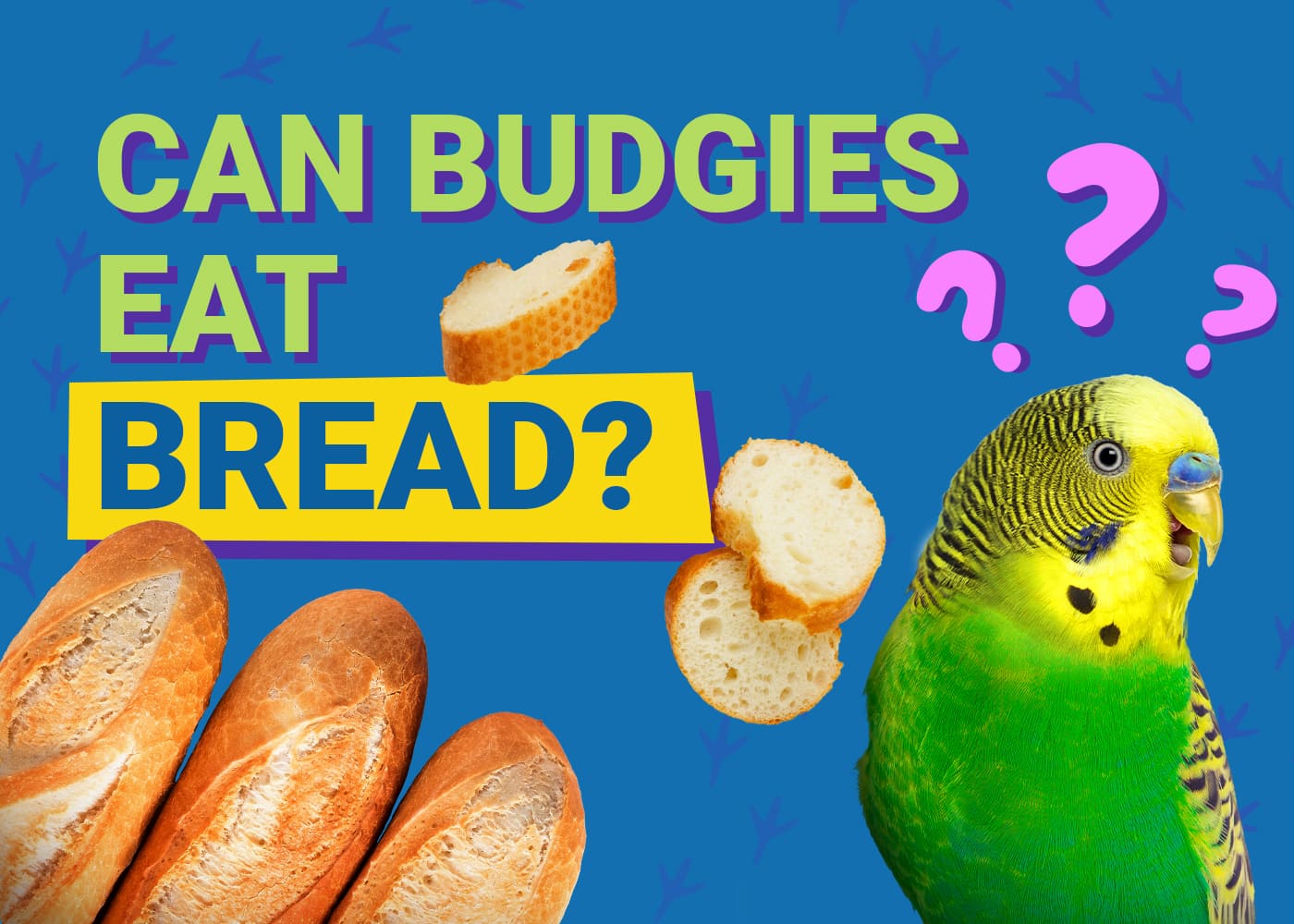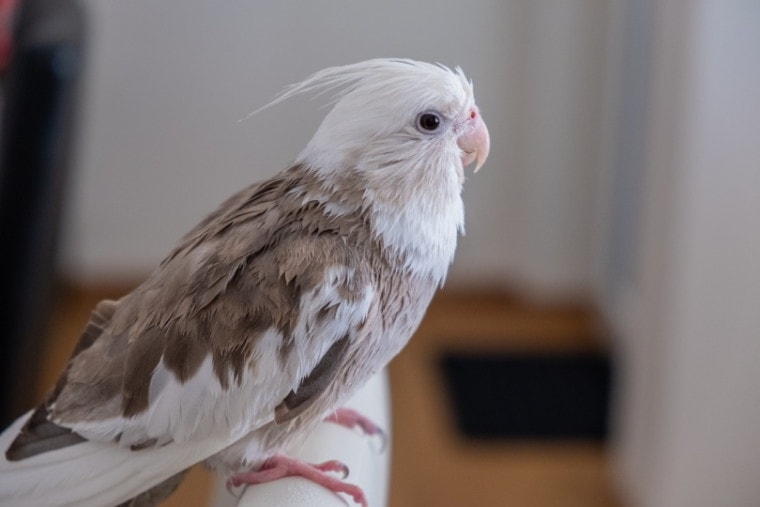
The White-Faced Cockatiel is a cockatiel color mutation. Genetically, this bird is typically grey with a white or grayish face. Unlike other cockatiels, this bird species stands out because it does not have orange cheek patches or yellow color.
Often confused with the Albino Cockatiel, the White-Faced Cockatiel has a grey plumage. This bird is a member of the Cockatoo family and is the second most popular caged bird.
If you are considering getting this bird as a pet, here are the details about its temperament, physical appearance, exercise needs, and diet requirements.
Species Overview
| Common Name | White-Faced Cockatiel |
| Scientific Name | Nymphicus hollandicus |
| Adult Size | 12-13 inches |
| Life Expectancy | 10-15 years |
Origin and History
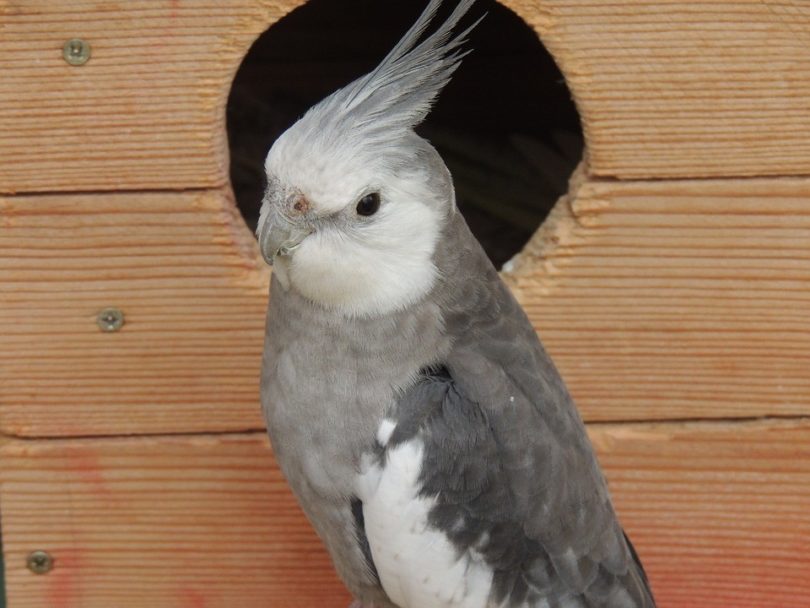
The White-Faced Cockatiel first appeared in 1964 in Holland. It’s a common mutation today and is the seventh established cockatiel mutation. These bird species are easy to breed and make great pets.
Like other cockatiels, they evolved as nomadic creatures, changing location according to food and water supplies.
They became well suited as pets due to their native habitat and adaptive behavior. Today, the White-Faced Cockatiels are not present in the wild. They are among the most popular pet birds from the parrot family.
During breeding, the dominant gene eliminates any yellow or orange coloring giving the bird a distinct look.
Temperament
White-Faced Cockatiels behave like other cockatiel bird species. Generally, cockatiels are social birds that enjoy spending time with their family and other cockatiels.
They are full of energy and very playful. Although they cannot talk as well as most parrots, they can learn a few tricks and gestures.
These birds can also co-exist peacefully with other cockatiels as long as the cage is big enough for both of them. When comparing between the male and female, the female is less aggressive. They’ll come out of the cage and go back without attacking the owner.
On the other hand, male White-Faced Cockatiels are more likely to struggle and attack you.
The females are loving and enjoy being petted. Due to the social nature of this species, it’s best to get a second bird for companionship if you are not home often. With proper socialization, they can be gentle and friendly.
Speech and Vocalizations
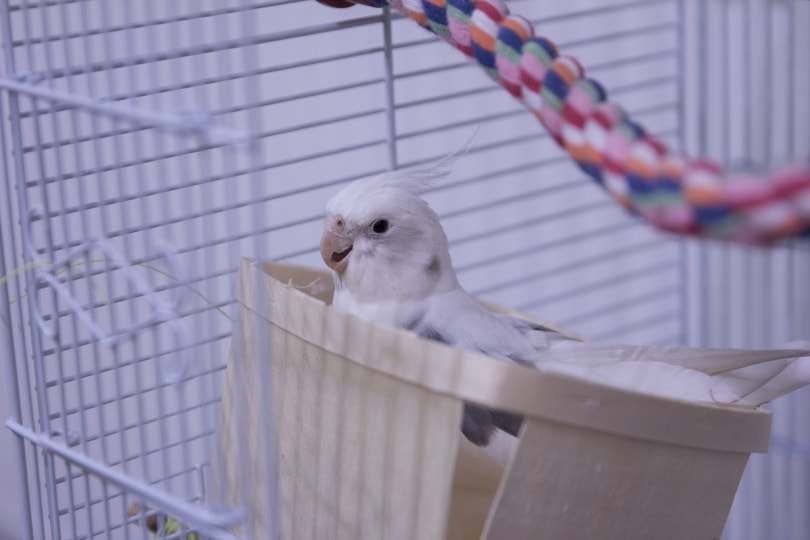
Unlike parrots, White-Faced Cockatiels can’t talk as well, but they learn how to mimic sounds and whistle. The male bird is a quick learner and starts making whistling sounds first. Generally, male cockatiels are better whistlers and speakers compared to their female counterparts. Therefore, you should pay attention to the female while training them.
This species mimic sound from inside and outside the house, such as phones, alarm clocks, doorbells, and other birds.
The sounds will always vary according to the situation. When they are happy, they whistle or chirp. They also scream when they sense danger. In case they feel danger, they make a hissing sound.
White-Faced Cockatiel Colors and Markings

The White-Faced Cockatiel has a striking mutation. The body is entirely charcoal grey with no orange cheek patches or yellow coloring. This coloration gets created by the autosomal recessive gene, which leads to the lipochromes pigment and stops the production of the yellow pigments.
This bird species also has the following mutations.
Cinnamon Pied
The grey marking is replaced with cinnamon coloring. It combines whites and cinnamons in a random pattern, which can be dominant or reverse.
Albino
This is a combination of a White-Faced Cockatiel and a Lutino Cockatiel. The White-Faced gene eliminates all the yellow and orange present in a Lutino, whereas the Lutino gene removes all the black and grey. This results in an all-white cockatiel with red eyes.
Pearl
This mutation happens similarly to the Pearl Cockatiel. The male will lose its pearl markings within the first molt at 6 months. However, the female retains the pearl markings.
Pied
The White-Faced Pied has a striking combination of whites and greys in a random pattern. Similar to the Pied cockatiel, you can’t determine the sex of these birds visually.
If you’re curious about the many color mutations and types of cockatiels, we can’t recommend the book The Ultimate Guide to Cockatiels enough!
This beautiful book (available on Amazon) features a detailed, illustrated guide to cockatiel color mutations, plus helpful tips on housing, feeding, breeding, and generally taking excellent care of your birds.
Caring for the White-Faced Cockatiel
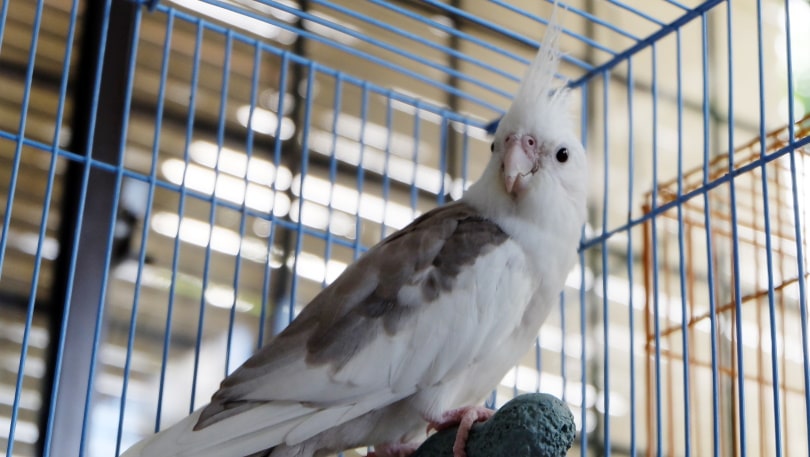
Once you get the White-Faced Cockatiel, here’s how to take care of it.
Grooming
Grooming birds involves trimming the nails and the beak. You can take your pet to the vet to have the beak trimmed professionally.
In some households, you may also need to trim your bird’s wings, especially if it’s unsafe for your small children. You can also do this if your doors are open, which is risky once your bird flies out. However, if there’s no real danger, you don’t need to trim the wings because the cockatiel needs them to exercise and fly when there’s danger.
If you have to trim them, take your pet to the vet to avoid injuring them.
White-Faced Cockatiels also need to take frequent baths. This is because they tend to produce excess feather dust. You can place a bowl of cool water in the cage two to three times a week for the bird to bathe.
Activities
White-Faced Cockatiels like to climb and play. Taking care of them includes providing lots of bird toys and exercise. You can give some toys in the cage to keep them stimulated. Also, give them some time outside the cage to exercise.
In addition, as social birds, they need companionship. If you are rarely at home, it’s best to get a second bird to keep your pet company. Otherwise, if left alone, they can be very destructive to items in your house.
Common Health Problems
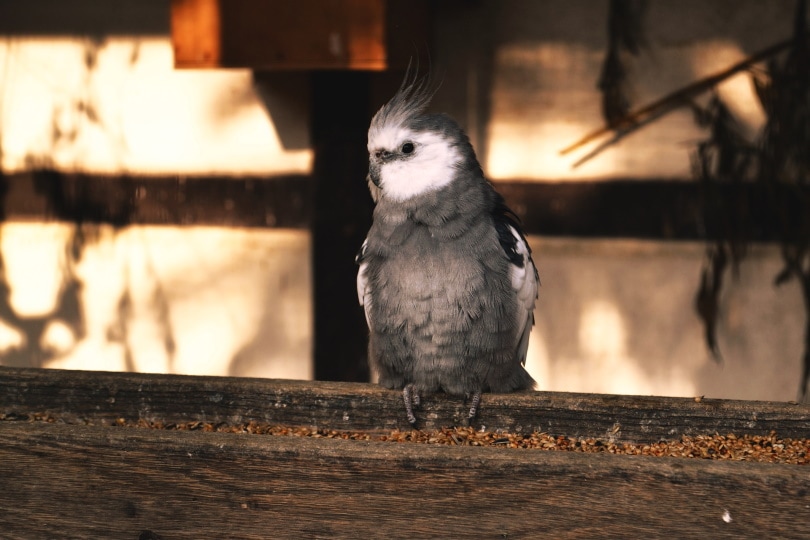
This bird species is typically hardy, healthy, and easy to maintain. However, like all pet birds, they suffer from some potential health problems. In order to take care of your cockatiel properly, it is good to know what signs of illness to look out for. Most signs manifest in the feathers, droppings, and wings.
Diet and Nutrition
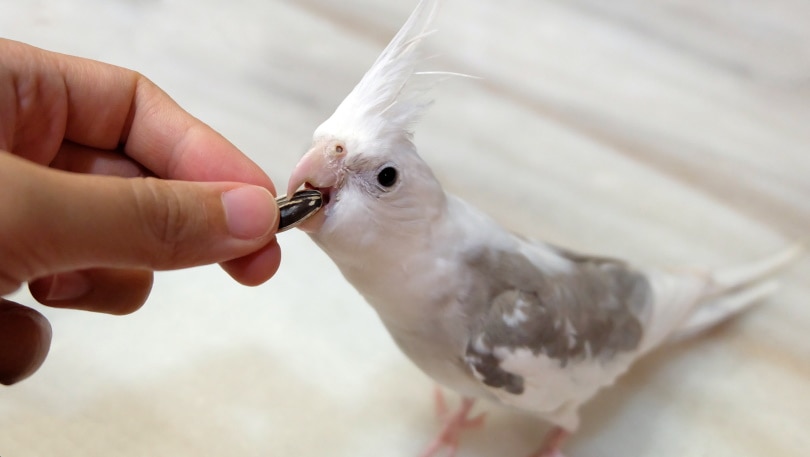
Baby White-Faced Cockatiels require feeding every couple of hours; otherwise, they’ll start being vocal when asking for food.
A healthy bird diet consists of various seeds, nuts, sprouts, fruits, vegetables, and commercial pellets. These cockatiels enjoy eating seeds; however, you should ensure that they are not high-fat because they can lead to obesity and fatty liver disorder.
When feeding your pet bird pellets, it should make up 75-80% of the entire diet. Fruits and vegetables should make up for the rest of the nutrients.
Older birds find it harder to let go of seeds and start eating pellets. If this happens, you should consult your vet on how best to plan your pet’s meals.
For breeding White-Faced Cockatiels, ensure that the diet is rich in protein.
Exercise
Exercise is good for your White-Faced Cockatiel. To ensure that your bird stays active and away from obesity, get them a cage big enough to fly around. These birds love climbing; therefore, you should include ladders and perches for them to fly around and play.
Apart from the playpen, you can also release them from the cage to fly around the house for about an hour daily. During this period, ensure the windows and doors are closed so that they can’t fly out. This activity is one way to ensure your bird gets their daily dose of exercise while also helping with socialization.
Also, add some toys for the bird to play with. This will keep them mentally stimulated. Once your bird gets bored, they’ll start looking for things to chew on and destroy things in your home. In addition, the bird might begin to nip and become more aggressive.
Where to Adopt or Buy a White-Faced Cockatiel
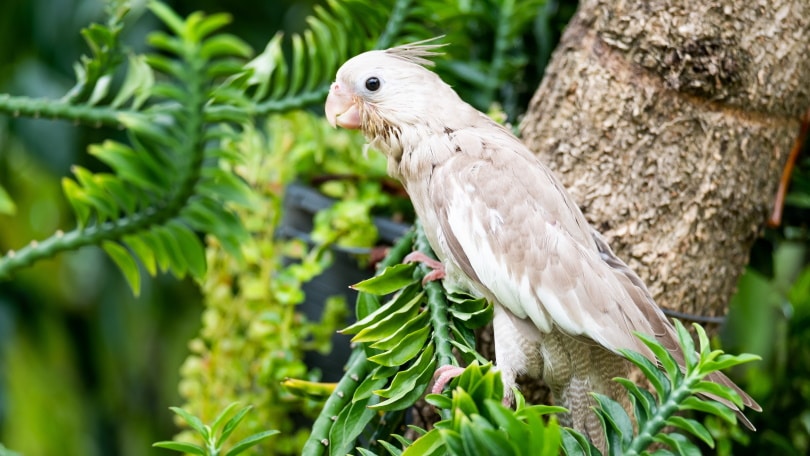
For $200-$300, you can get yourself a White-Faced Cockatiel from a reputable breeder. The price depends on the age, mutation, health, and personality of the specific bird. This bird is available for sale in different varieties at the breeder’s, including grey, lutino, pearl, pied, and cinnamon.
The White-Faced will usually be more expensive. If it becomes hard to find, you can consult breeders in your area to help you find one of these breeds. You can also check pet stores that might have them available in your area.
If you are looking to adopt, visit pet rescue centers and adoption centers to check whether they have available White-Faced Cockatiels. The prices at these places might be considerably lower than at the breeders. As you adopt one, make sure you get all the background information about the bird’s health for easier management.
Final Thoughts
The White-Faced Cockatiel is a stunning bird. Its unique features make it one of the most popular pet birds. Before bringing one to your home, it’s best to ensure that you know all the health care needs, diet and nutrition requirements, grooming needs, and exercising needs. If you can provide these, your pet bird will live longer and stay healthy.
This bird is a social bird; therefore, you will need a companion bird if you are rarely home. It also loves to exercise; therefore, ensure that you provide the necessary accessories in the cage. White-Faced Cockatiels are calm and gentle when socialized well and make excellent pets.
Featured Image Credit: Zdenka Kincel, Shutterstock



